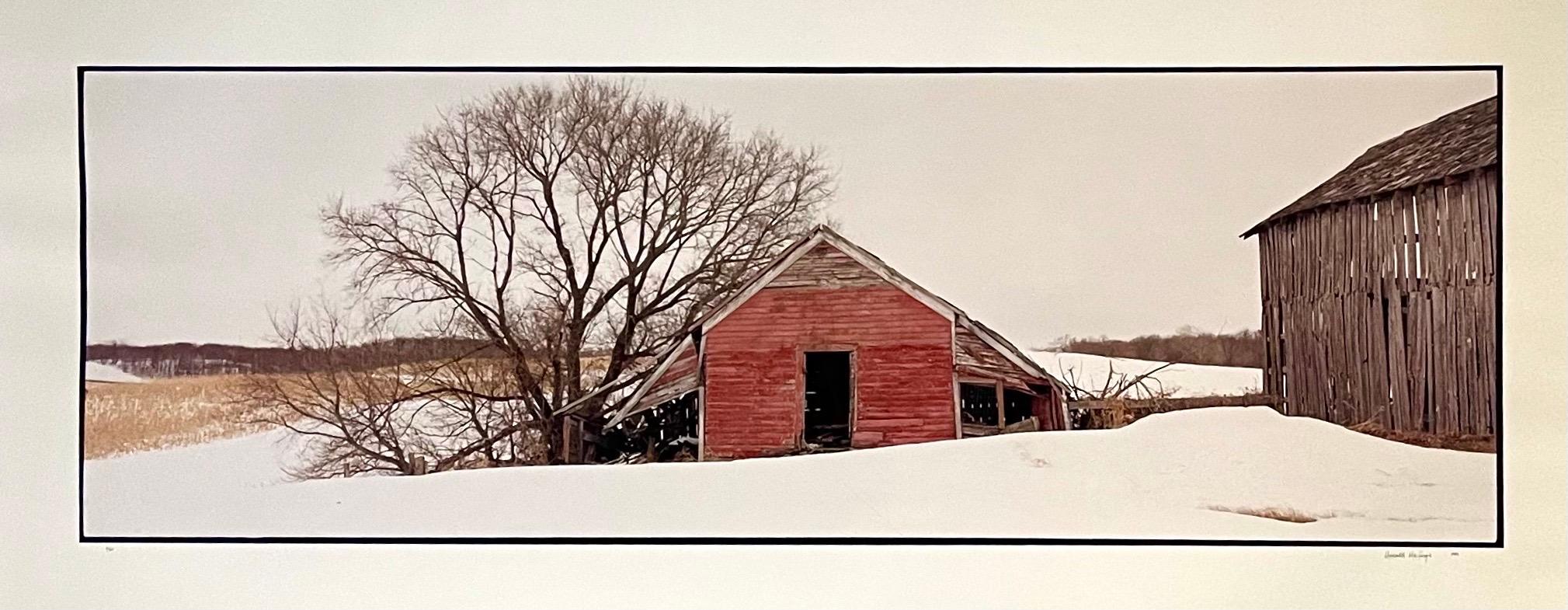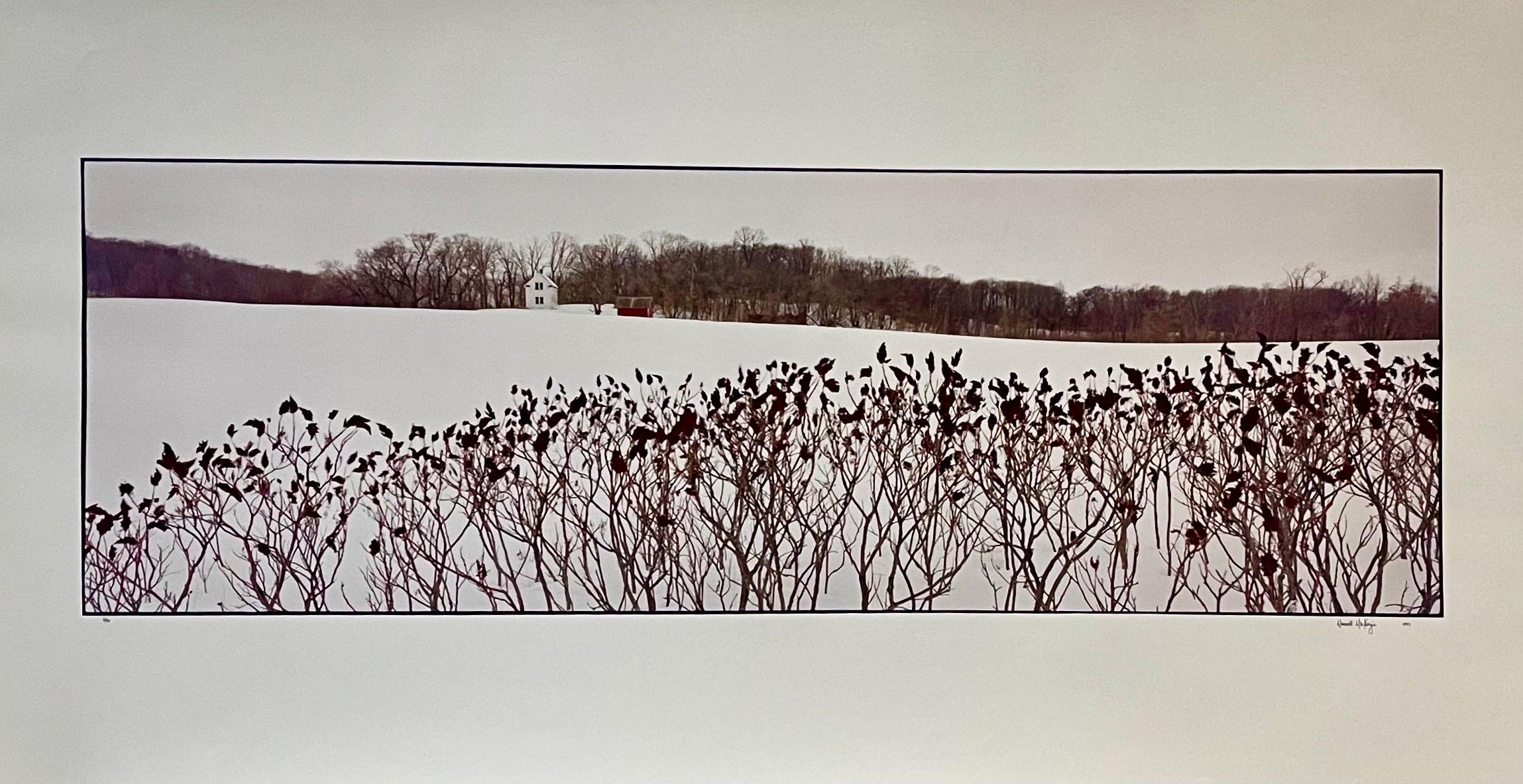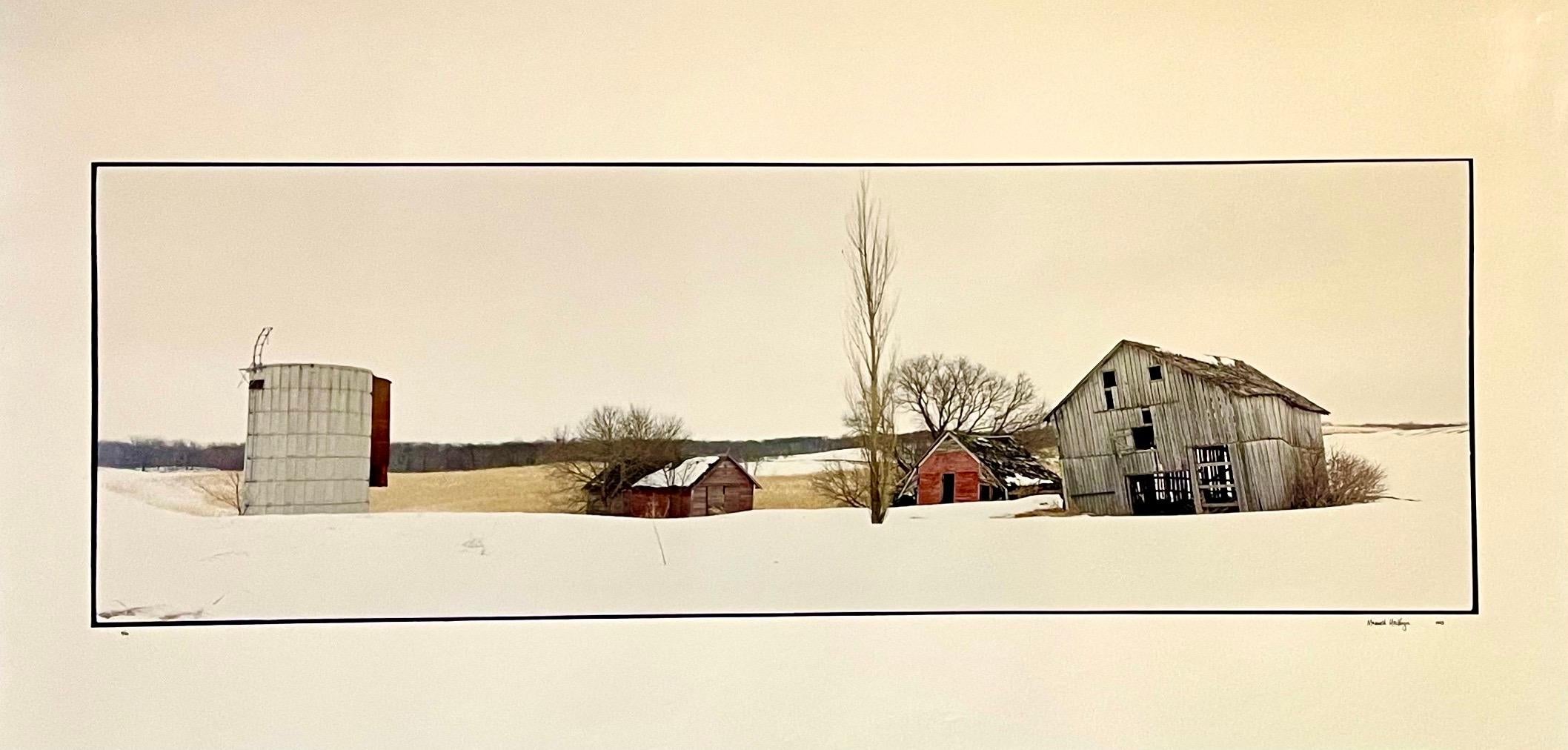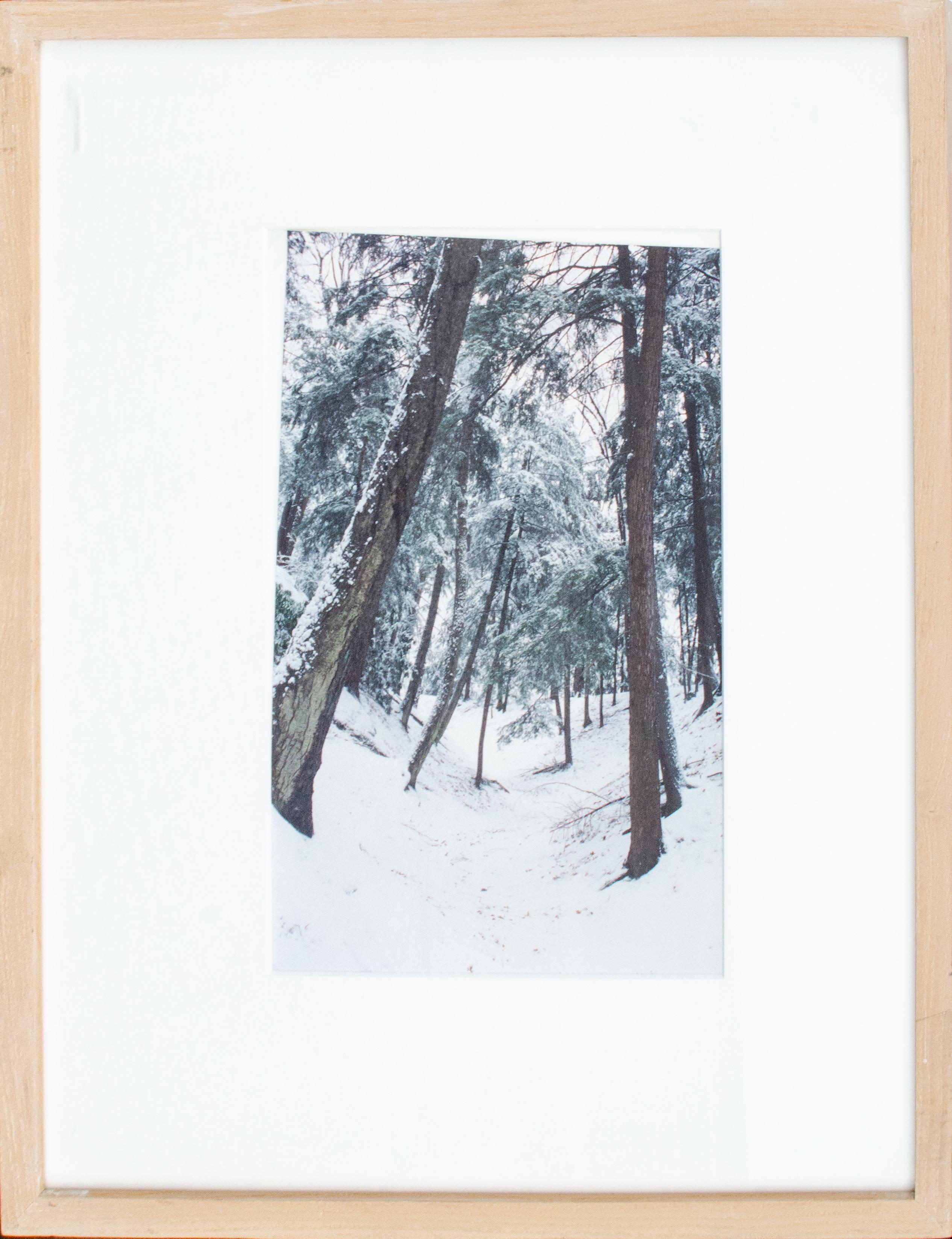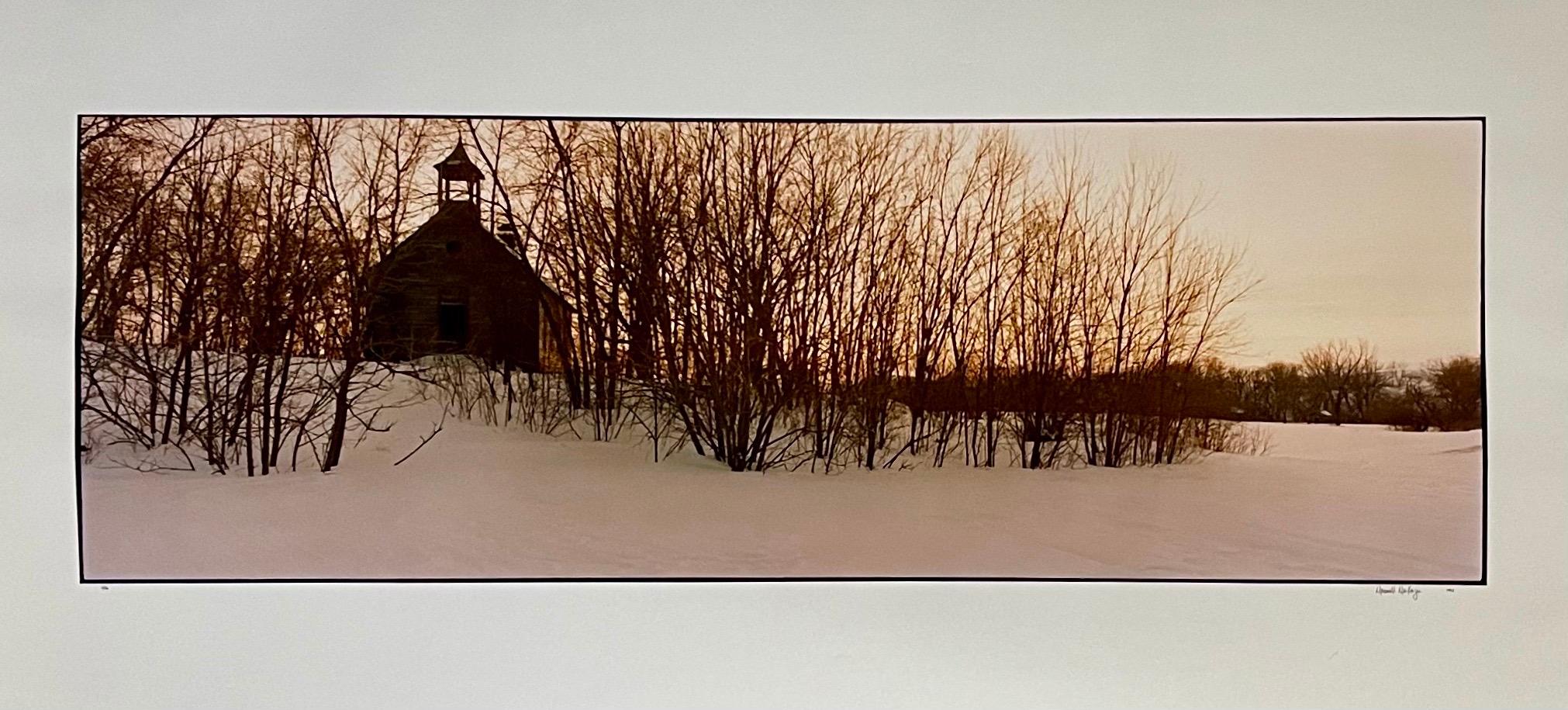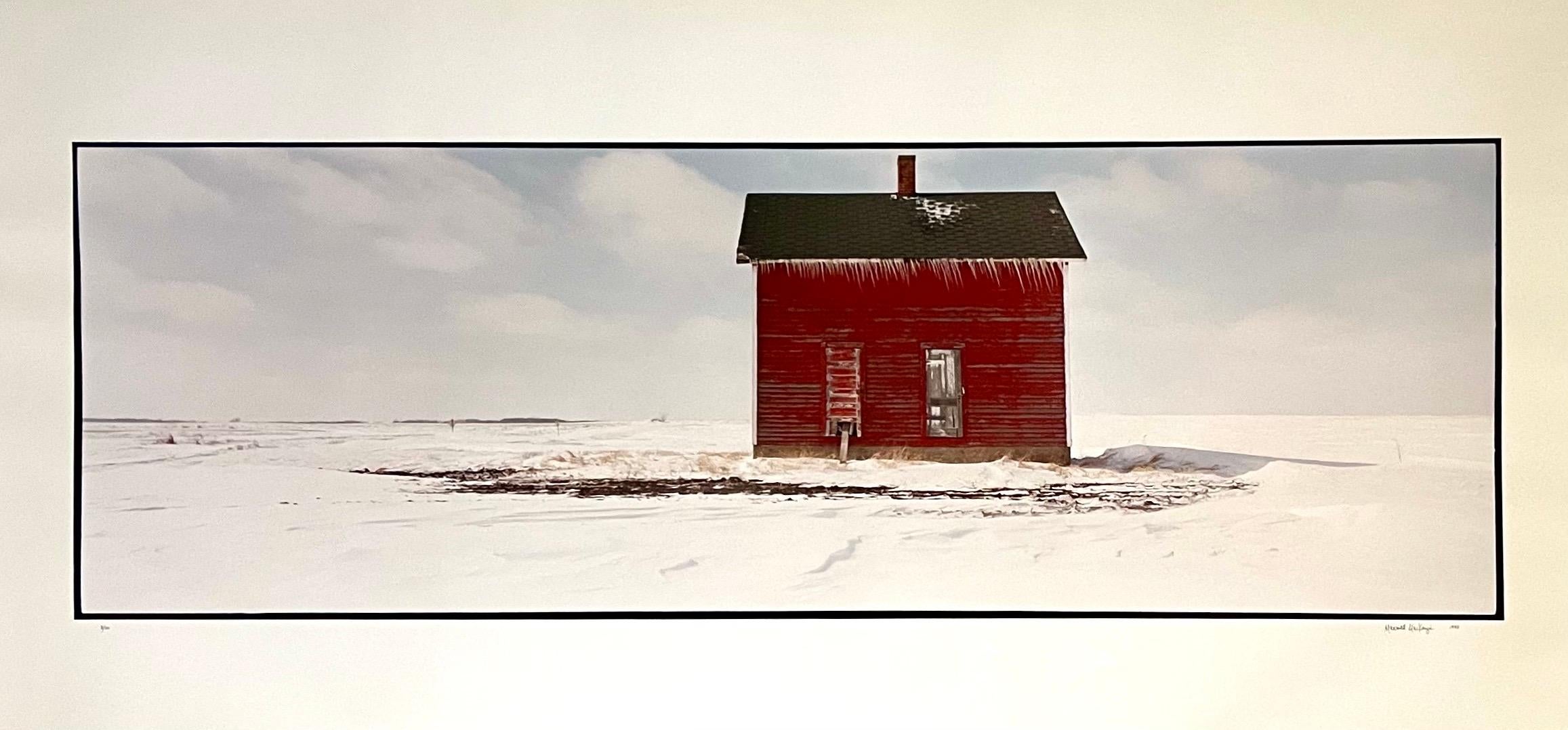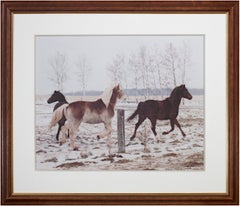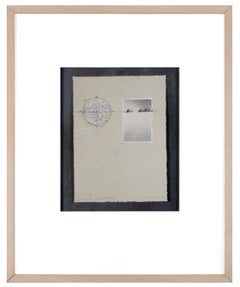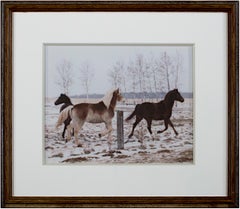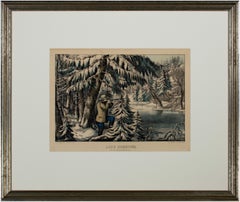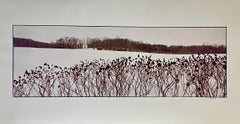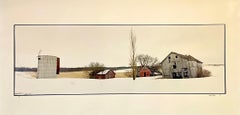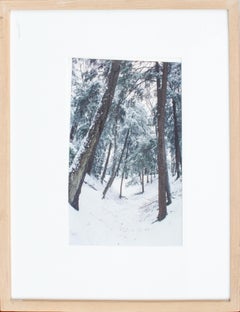Items Similar to "Country Medley II, signed (Series of 6), " Winter Photographs by Charles Auer
Video Loading
Want more images or videos?
Request additional images or videos from the seller
1 of 9
Charles Auer"Country Medley II, signed (Series of 6), " Winter Photographs by Charles Auer1979
1979
$942
£711.36
€814.44
CA$1,330.35
A$1,452.42
CHF 761.45
MX$17,640.25
NOK 9,509.23
SEK 8,979.25
DKK 6,078.95
About the Item
"Country Medley II" is a signed series of photographs by Charles Auer. It includes 6 photographs of a rural farm setting in winter. Signed to lower right of mat.
4" x 6" art (each)
20" x 16" frame
- Creator:Charles Auer
- Creation Year:1979
- Dimensions:Height: 20 in (50.8 cm)Width: 16 in (40.64 cm)
- Medium:
- Period:
- Condition:
- Gallery Location:Milwaukee, WI
- Reference Number:Seller: 842d1stDibs: LU60532041643
About the Seller
4.9
Platinum Seller
Premium sellers with a 4.7+ rating and 24-hour response times
Established in 1966
1stDibs seller since 2017
447 sales on 1stDibs
Typical response time: 3 hours
- ShippingRetrieving quote...Shipping from: Milwaukee, WI
- Return Policy
Authenticity Guarantee
In the unlikely event there’s an issue with an item’s authenticity, contact us within 1 year for a full refund. DetailsMoney-Back Guarantee
If your item is not as described, is damaged in transit, or does not arrive, contact us within 7 days for a full refund. Details24-Hour Cancellation
You have a 24-hour grace period in which to reconsider your purchase, with no questions asked.Vetted Professional Sellers
Our world-class sellers must adhere to strict standards for service and quality, maintaining the integrity of our listings.Price-Match Guarantee
If you find that a seller listed the same item for a lower price elsewhere, we’ll match it.Trusted Global Delivery
Our best-in-class carrier network provides specialized shipping options worldwide, including custom delivery.More From This Seller
View All'Jacob's Horses, Ashland, WI' original photograph by Jacob Obletz
By Jacob Obletz
Located in Milwaukee, WI
Jacob Obletz (American, b. 1975) has worked with horses much of his life. He grew up in Milwaukee, but has become comfortable in the woods, producing maple syrup and using Belgian draft horses to log the forests of Wisconsin. He has worked with horses much of his life, and his photographs of horses...
Category
Early 2000s Contemporary Figurative Photography
Materials
Photographic Paper
"Field Study - Winter Patterns, " Collage
By Terri Warpinski
Located in Milwaukee, WI
"Field Study - Winter Patterns" is a mixed media piece by Terri Warpinski using photographs, drawings, and fragments of notebook and sketchbook paper. The artist signed the piece in ...
Category
1990s Surrealist Mixed Media
Materials
Paper, Mixed Media, Photographic Paper, Graphite
'Jacob's Horses, Ashland, WI' original photograph by Jacob Obletz
By Jacob Obletz
Located in Milwaukee, WI
Jacob Obletz (American, b. 1975) has worked with horses much of his life. He grew up in Milwaukee, but has become comfortable in the woods, producing maple syrup and using Belgian draft horses to log the forests of Wisconsin. He has worked with horses much of his life, and his photographs of horses...
Category
Early 2000s Contemporary Figurative Photography
Materials
Photographic Paper
19th century color lithograph nature figure winter scene trees snow river
By Currier & Ives
Located in Milwaukee, WI
"Deer Shooting in the Northern Woods" is an original hand-colored lithograph by Currier & Ives. It depicts a landscape with a hunter aiming his gun at a deer on a winter day.
10" x 14" art
19 1/2" x 23 1/4" frame
Nathaniel Currier was a tall introspective man with a melancholy nature. He could captivate people with his piercing stare or charm them with his sparkling blue eyes. Nathaniel was born in Roxbury, Massachusetts on March 27th, 1813, the second of four children. His parents, Nathaniel and Hannah Currier, were distant cousins who lived a humble yet spartan life. When Nathaniel was eight years old, tragedy struck. Nathaniel’s father unexpectedly passed away leaving Nathaniel and his eleven-year-old brother Lorenzo to provide for the family. In addition to their mother, Nathaniel and Lorenzo had to care for six-year-old sister Elizabeth and two-year-old brother Charles. Nathaniel worked a series of odd jobs to support the family, and at fifteen, he started what would become a life-long career when he apprenticed in the Boston lithography shop of William and John Pendleton.
A Bavarian gentleman named Alois Senefelder invented lithography just 30 years prior to young Nat Currier’s apprenticeship. While under the employ of the brothers Pendleton, Nat was taught the art of lithography by the firm’s chief printer, a French national named Dubois, who brought the lithography trade to America.
Lithography involves grinding a piece of limestone flat and smooth then drawing in mirror image on the stone with a special grease pencil. After the image is completed, the stone is etched with a solution of aqua fortis leaving the greased areas in slight relief. Water is then used to wet the stone and greased-ink is rolled onto the raised areas. Since grease and water do not mix, the greased-ink is repelled by the moisture on the stone and clings to the original grease pencil lines. The stone is then placed in a press and used as a printing block to impart black on white images to paper.
In 1833, now twenty-years old and an accomplished lithographer, Nat Currier left Boston and moved to Philadelphia to do contract work for M.E.D. Brown, a noted engraver and printer. With the promise of good money, Currier hired on to help Brown prepare lithographic stones of scientific images for the American Journal of Sciences and Arts. When Nat completed the contract work in 1834, he traveled to New York City to work once again for his mentor John Pendleton, who was now operating his own shop located at 137 Broadway. Soon after the reunion, Pendleton expressed an interest in returning to Boston and offered to sell his print shop to Currier. Young Nat did not have the financial resources to buy the shop, but being the resourceful type he found another local printer by the name of Stodart. Together they bought Pendleton’s business.
The firm ‘Currier & Stodart’ specialized in "job" printing. They produced many different types of printed items, most notably music manuscripts for local publishers. By 1835, Stodart was frustrated that the business was not making enough money and he ended the partnership, taking his investment with him. With little more than some lithographic stones, and a talent for his trade, twenty-two year old Nat Currier set up shop in a temporary office at 1 Wall Street in New York City. He named his new enterprise ‘N. Currier, Lithographer’
Nathaniel continued as a job printer and duplicated everything from music sheets to architectural plans. He experimented with portraits, disaster scenes and memorial prints, and any thing that he could sell to the public from tables in front of his shop. During 1835 he produced a disaster print Ruins of the Planter's Hotel, New Orleans, which fell at two O’clock on the Morning of the 15th of May 1835, burying 50 persons, 40 of whom Escaped with their Lives. The public had a thirst for newsworthy events, and newspapers of the day did not include pictures. By producing this print, Nat gave the public a new way to “see” the news. The print sold reasonably well, an important fact that was not lost on Currier.
Nat met and married Eliza Farnsworth in 1840. He also produced a print that same year titled Awful Conflagration of the Steamboat Lexington in Long Island Sound on Monday Evening, January 18, 1840, by which melancholy occurrence over One Hundred Persons Perished. This print sold out very quickly, and Currier was approached by an enterprising publication who contracted him to print a single sheet addition of their paper, the New York Sun. This single page paper is presumed to be the first illustrated newspaper ever published.
The success of the Lexington print launched his career nationally and put him in a position to finally lift his family up. In 1841, Nat and Eliza had their first child, a son they named Edward West Currier. That same year Nat hired his twenty-one year old brother Charles and taught him the lithography trade, he also hired his artistically inclined brother Lorenzo to travel out west and make sketches of the new frontier as material for future prints. Charles worked for the firm on and off over the years, and invented a new type of lithographic crayon which he patented and named the Crayola. Lorenzo continued selling sketches to Nat for the next few years.
In 1843, Nat and Eliza had a daughter, Eliza West Currier, but tragedy struck in early 1847 when their young daughter died from a prolonged illness. Nat and Eliza were grief stricken, and Eliza, driven by despair, gave up on life and passed away just four months after her daughter’s death.
The subject of Nat Currier’s artwork changed following the death of his wife and daughter, and he produced many memorial prints and sentimental prints during the late 1840s. The memorial prints generally depicted grief stricken families posed by gravestones (the stones were left blank so the purchasers could fill in the names of the dearly departed). The sentimental prints usually depicted idealized portraits of women and children, titled with popular Christian names of the day.
Late in 1847, Nat Currier married Lura Ormsbee, a friend of the family. Lura was a self-sufficient woman, and she immediately set out to help Nat raise six-year-old Edward and get their house in order. In 1849, Lura delivered a son, Walter Black Currier, but fate dealt them a blow when young Walter died one year later. While Nat and Lura were grieving the loss of their new son, word came from San Francisco that Nat’s brother Lorenzo had also passed away from a brief illness. Nat sank deeper into his natural quiet melancholy. Friends stopped by to console the couple, and Lura began to set an extra place at their table for these unexpected guests. She continued this tradition throughout their lives.
In 1852, Charles introduced a friend, James Merritt Ives, to Nat and suggested he hire him as a bookkeeper. Jim Ives was a native New Yorker born in 1824 and raised on the grounds of Bellevue Hospital where his father was employed as superintendent. Jim was a self-trained artist and professional bookkeeper. He was also a plump and jovial man, presenting the exact opposite image of his new boss.
Jim Ives met Charles Currier through Caroline Clark, the object of Jim’s affection. Caroline’s sister Elizabeth was married to Charles, and Caroline was a close friend of the Currier family. Jim eventually proposed marriage to Caroline and solicited an introduction to Nat Currier, through Charles, in hopes of securing a more stable income to support his future wife.
Ives quickly set out to improve and modernize his new employer’s bookkeeping methods. He reorganized the firm’s sizable inventory, and used his artistic skills to streamline the firm’s production methods. By 1857, Nathaniel had become so dependent on Jims’ skills and initiative that he offered him a full partnership in the firm and appointed him general manager. The two men chose the name ‘Currier & Ives’ for the new partnership, and became close friends.
Currier & Ives produced their prints in a building at 33 Spruce Street where they occupied the third, fourth and fifth floors. The third floor was devoted to the hand operated printing presses that were built by Nat's cousin, Cyrus Currier, at his shop Cyrus Currier & Sons in Newark, NJ. The fourth floor found the artists, lithographers and the stone grinders at work. The fifth floor housed the coloring department, and was one of the earliest production lines in the country. The colorists were generally immigrant girls, mostly German, who came to America with some formal artistic training. Each colorist was responsible for adding a single color to a print. As a colorist finished applying their color, the print was passed down the line to the next colorist to add their color. The colorists worked from a master print displayed above their table, which showed where the proper colors were to be placed. At the end of the table was a touch up artist who checked the prints for quality, touching-in areas that may have been missed as it passed down the line. During the Civil War, demand for prints became so great that coloring stencils were developed to speed up production.
Although most Currier & Ives prints were colored in house, some were sent out to contract artists. The rate Currier & Ives paid these artists for coloring work was one dollar per one hundred small folios (a penny a print) and one dollar per one dozen large folios. Currier & Ives also offered uncolored prints to dealers, with instructions (included on the price list) on how to 'prepare the prints for coloring.' In addition, schools could order uncolored prints from the firm’s catalogue to use in their painting classes.
Nathaniel Currier and James Merritt Ives attracted a wide circle of friends during their years in business. Some of their more famous acquaintances included Horace Greeley, Phineas T. Barnum, and the outspoken abolitionists Rev. Henry Ward, and John Greenleaf Whittier (the latter being a cousin of Mr. Currier).
Nat Currier and Jim Ives described their business as "Publishers of Cheap and Popular Pictures" and produced many categories of prints. These included Disaster Scenes, Sentimental Images, Sports, Humor, Hunting Scenes, Politics, Religion, City and Rural Scenes, Trains, Ships, Fire Fighters, Famous Race Horses, Historical Portraits, and just about any other topic that satisfied the general public's taste. In all, the firm produced in excess of 7500 different titles, totaling over one million prints produced from 1835 to 1907.
Nat Currier retired in 1880, and signed over his share of the firm to his son Edward. Nat died eight years later at his summer home 'Lion’s Gate' in Amesbury, Massachusetts. Jim Ives remained active in the firm until his death in 1895, when his share of the firm passed to his eldest son, Chauncey.
In 1902, faced will failing health from the ravages of Tuberculosis, Edward Currier sold his share of the firm to Chauncey Ives. In 1907, faced with competitive pressures from advancements in offset printing and photo engraving, Chauncey closed the venerable lithography business and sold the printing equipment and lithographic stones to his shop foreman, Daniel W. Logan.
Nathaniel Currier and James Merritt Ives are laid to rest along with their families at the Greenwood Cemetery...
Category
1860s Other Art Style Landscape Prints
Materials
Lithograph
'Winter Silhouettes, ' offset lithograph by Schomer Lichtner
By Schomer Lichtner
Located in Milwaukee, WI
'Winter Silhouettes,' a small and delicate print, is an original offset lithograph by the Milwaukee artist Schomer Lichtner. The composition displays registers of foliage, emerging from the white of the paper as though emerging from the snow-covered ground. The artwork is thus plays with the materials of printmaking; the paper is both the support and the primary indication of the season. The subtle texture of the tooth of the paper also adds life to the image, giving the snow a wind-swept, creature trodden surface. The free forms of the grasses and leaves resemble the lyrical mid-century works of the French artist Henri Matisse, which combined with these material concerns demonstrate Lichter's modern sensibilities.
3.75 x 2.75 inches, image
5.5 x 4.5 inches, paper
10 x 8 inches frame
Signed and dated in the stone, lower right
Framed to conservation standards in a shadow-box style mounting, using 100 percent rag matting, museum glass, and housed in a cherry wood moulding
Overall excellent condition; some toning to edges of paper; some minor abrasions to frame
Milwaukee artist Schomer Lichtner was well known for his whimsical cows and ballerinas and abstract imagery. He and his late wife Ruth Grotenrath, both well-known Wisconsin artists, began their prolific careers as muralists for WPA projects, primarily post offices.
Lichtner also painted murals for industry and private clients. Schomer was a printmaker and produced block prints, lithographs, and serigraph prints. His casein (paint made from dairy products) and acrylic paintings are of the rural Wisconsin landscape and farm animals. He became interested in cows when he and Ruth spent summers near Holy Hill in Washington County. According to David Gordon, director of the Milwaukee Art Museum, Schomer Lichtner had a tremendous joie de vivre and expressed it in his art.
Schomer Lichtner was nationally known for his whimsical paintings and sculptures of black- and white-patterned Holstein cows and elegant ballerina dancers. Lichtner also painted all sorts of combinations of beautiful women, flowers and country landscapes. James Auer, former Milwaukee Journal Sentinel art critic, said that his art eventually "exploded into expressionistic design elements with bold, flat areas of color and high energy that anticipated Pop Art." Auer went on to describe Lichtner’s work as full of "wit, vigor and virtuosity."
As early as 1930, Lichtner’s work was shown at the prestigious Carnegie International Exhibition in New York and at museums throughout the Midwest. As a student, he was a protégé of another icon of 20th century American art, Gustave Moeller.
Lichtner and his wife, Ruth Grotenrath (1912-1988), are celebrated as Milwaukee’s first couple of painting and are regarded as major Wisconsin artists. Lichtner’s impressive production, perseverance, longevity, and positive approach to his life and art made him and his work distinctive and much loved by his many admirers. His work is currently represented in collections at the Milwaukee Art Museum, the John Michael Kohler Art Center, the West Bend Museum, and in the collections of many individuals. Books on the lives and art work of both Lichtner and Grotenrath are in progress and it is anticipated that they will be published next year.
Schomer Lichtner passed away on May 9, 2006 at the age of 101. He continued to amaze and create with his whimsical paintings of ballerinas...
Category
1960s American Modern Landscape Prints
Materials
Black and White, Lithograph
"Season's Greetings, " Winter Landscape Lithograph in Blue signed by Mark Mille
By Mark Mille 1
Located in Milwaukee, WI
"Season's Greetings" is an original lithograph by Mark Mille. The artist signed the piece lower right and wrote the edition number (25/40) in the lower left. It features a winter river scene...
Category
1980s Post-Modern Landscape Prints
Materials
Lithograph
You May Also Like
Farm, Winter Landscape, Large Panoramic Vintage Color Photograph Signed Photo
By Maxwell Mackenzie
Located in Surfside, FL
Maplewood Township Homestead, Winter, 1993
Fabulous American landscape photography of a rural landscape scene.
from small hand signed edition of 20
Large Format Chromogenic print on Kodak Professional Paper
The sheets are approximately 30 X 56 inches
the images are around 16 X 48.25 inches
Some of them are cut a bit irregularly, they should all mat out fine for framing.
These are vintage large-format architectural chromogenic print photographs hand signed and dated and hand numbered from the edition of 20 in the lower margin.
The collection depicts attractive examples of Mackenzie's wide-lens studies of architecture, such as barns and abandoned houses, set into richly colored landscapes.
Maxwell MacKenzie is an award-winning professional and fine-art photographer based in Washington, DC and Minnesota. Over the past thirty-five years, his photographic assignments have taken him to 20 states and a dozen foreign countries, including Austria, the Bahamas, Bermuda, Brazil, Brussels, England, France, Greece, Morocco, Norway, Sweden, and Wales.
Three books of Mackenzie's fine-art photographs have been published: Abandonings, (1995), color panoramic photographs of his native Otter Tail County, MN, which was awarded the Silver Medal Award for Excellence from Photo District News; American Ruins, Ghosts on the Landscape, (2001) black & white panoramics made in Montana, Idaho, Minnesota, Wisconsin and the Dakotas; and Markings, (2007), color abstract aerials made from his self-piloted, powered-parachute, a 300 pound, ultra-light aircraft.
MacKenzie’s work is included in the permanent collection of The Phillips Collection as well as hundreds of private and corporate collections, including Exxon, Citibank, Deloitte & Touche, Dow Jones, Fannie Mae, The New York Hospital, Goldman Sachs, JP Morgan, the Union Bank of Switzerland, Phillip Morris, and the Washington Post. His fine-art photographs of the American West are also included in numerous American Embassy collections including Bogota, Lima, Lagos, and Moscow.
His work has been exhibited in dozens of museums and galleries all over the country, including solo shows at The Contemporary Art Center of Virginia, Virginia Beach; The American Institute of Architects, DC; The Nordic Heritage Museum, in Seattle, WA; The Piedmont Arts Association, Martinsville, VA; the Julie Saul Gallery in NYC, the DNJ Gallery in LA; The Gallatin River Gallery...
Category
1990s American Realist Color Photography
Materials
Color
Farm, Winter Landscape, Large Panoramic Vintage Color Photograph Signed Photo
By Maxwell Mackenzie
Located in Surfside, FL
Maplewood Township Homestead, Winter, 1993
Fabulous American landscape photography of a rural landscape scene.
from small hand signed edition of 20
Large Format Chromogenic print on...
Category
1990s American Realist Color Photography
Materials
Color
Farm, Winter Landscape, Large Panoramic Vintage Color Photograph Signed Photo
By Maxwell Mackenzie
Located in Surfside, FL
Maplewood Township Homestead, Winter, 1993
Fabulous American landscape photography of a rural landscape scene.
from small hand signed edition of 20
Large Format Chromogenic print on Kodak Professional Paper
The sheets are approximately 30 X 56 inches
the images are around 16 X 48.25 inches
Some of them are cut a bit irregularly, they should all mat out fine for framing.
These are vintage large-format architectural chromogenic print photographs hand signed and dated and hand numbered from the edition of 20 in the lower margin.
The collection depicts attractive examples of Mackenzie's wide-lens studies of architecture, such as barns and abandoned houses, set into richly colored landscapes.
Maxwell MacKenzie is an award-winning professional and fine-art photographer based in Washington, DC and Minnesota. Over the past thirty-five years, his photographic assignments have taken him to 20 states and a dozen foreign countries, including Austria, the Bahamas, Bermuda, Brazil, Brussels, England, France, Greece, Morocco, Norway, Sweden, and Wales.
Three books of Mackenzie's fine-art photographs have been published: Abandonings, (1995), color panoramic photographs of his native Otter Tail County, MN, which was awarded the Silver Medal Award for Excellence from Photo District News; American Ruins, Ghosts on the Landscape, (2001) black & white panoramics made in Montana, Idaho, Minnesota, Wisconsin and the Dakotas; and Markings, (2007), color abstract aerials made from his self-piloted, powered-parachute, a 300 pound, ultra-light aircraft.
MacKenzie’s work is included in the permanent collection of The Phillips Collection as well as hundreds of private and corporate collections, including Exxon, Citibank, Deloitte & Touche, Dow Jones, Fannie Mae, The New York Hospital, Goldman Sachs, JP Morgan, the Union Bank of Switzerland, Phillip Morris, and the Washington Post. His fine-art photographs of the American West are also included in numerous American Embassy collections including Bogota, Lima, Lagos, and Moscow.
His work has been exhibited in dozens of museums and galleries all over the country, including solo shows at The Contemporary Art Center of Virginia, Virginia Beach; The American Institute of Architects, DC; The Nordic Heritage Museum, in Seattle, WA; The Piedmont Arts Association, Martinsville, VA; the Julie Saul Gallery in NYC, the DNJ Gallery in LA; The Gallatin River Gallery...
Category
1990s American Realist Color Photography
Materials
Color
Glen Park Wintery Landscape Photo, Stroudsburg PA, by Steve Waters
Located in New York, NY
Steve Waters
Glen Park, 1995
Black and white photo print
Sight: 11.75 x 7.75 in.
Framed: 19 5/8 x 16 x 1 1/2 in.
Provenance:
The Artist
Category
1990s Contemporary Landscape Photography
Materials
Black and White
Architecture, Winter Landscape, Large Panoramic Color Photograph Signed Photo
By Maxwell Mackenzie
Located in Surfside, FL
Fabulous American landscape photography of a rural landscape scene.
from small hand signed edition of 20
Large Chromogenic print on Kodak Professional Paper
The sheets are approxima...
Category
1990s American Realist Color Photography
Materials
Color
Farm, Winter Landscape, Large Panoramic Vintage Color Photograph Signed Photo
By Maxwell Mackenzie
Located in Surfside, FL
Maplewood Township Homestead, Winter, 1993
Fabulous American landscape photography of a rural landscape scene.
from small hand signed edition of 20
Large Format Chromogenic print on Kodak Professional Paper
The sheets are approximately 30 X 56 inches
the images are around 16 X 48.25 inches
Some of them are cut a bit irregularly, they should all mat out fine for framing.
These are vintage large-format architectural chromogenic print photographs hand signed and dated and hand numbered from the edition of 20 in the lower margin.
The collection depicts attractive examples of Mackenzie's wide-lens studies of architecture, such as barns and abandoned houses, set into richly colored landscapes.
Maxwell MacKenzie is an award-winning professional and fine-art photographer based in Washington, DC and Minnesota. Over the past thirty-five years, his photographic assignments have taken him to 20 states and a dozen foreign countries, including Austria, the Bahamas, Bermuda, Brazil, Brussels, England, France, Greece, Morocco, Norway, Sweden, and Wales.
Three books of Mackenzie's fine-art photographs have been published: Abandonings, (1995), color panoramic photographs of his native Otter Tail County, MN, which was awarded the Silver Medal Award for Excellence from Photo District News; American Ruins, Ghosts on the Landscape, (2001) black & white panoramics made in Montana, Idaho, Minnesota, Wisconsin and the Dakotas; and Markings, (2007), color abstract aerials made from his self-piloted, powered-parachute, a 300 pound, ultra-light aircraft.
MacKenzie’s work is included in the permanent collection of The Phillips Collection as well as hundreds of private and corporate collections, including Exxon, Citibank, Deloitte & Touche, Dow Jones, Fannie Mae, The New York Hospital, Goldman Sachs, JP Morgan, the Union Bank of Switzerland, Phillip Morris, and the Washington Post. His fine-art photographs of the American West are also included in numerous American Embassy collections including Bogota, Lima, Lagos, and Moscow.
His work has been exhibited in dozens of museums and galleries all over the country, including solo shows at The Contemporary Art Center of Virginia, Virginia Beach; The American Institute of Architects, DC; The Nordic Heritage Museum, in Seattle, WA; The Piedmont Arts Association, Martinsville, VA; the Julie Saul Gallery in NYC, the DNJ Gallery in LA; The Gallatin River Gallery...
Category
1990s American Realist Color Photography
Materials
Color
